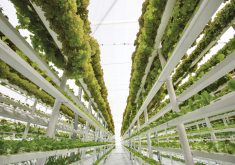Consumers are watching you like never before. But relax — you can only do so much.
That was one key message from a recent panel discussion on how farmers can connect with consumers.
The sudden fascination with how food is produced is a “profoundly good thing,” said Mike von Massow, an associate professor at the University of Guelph.
“As consumers are becoming more engaged in food and thinking about food, there’s more value in that food,” said von Massow, an expert on supply chains and topics such as local food.
Read Also

Farming Smarter receives financial boost from Alberta government for potato research
Farming Smarter near Lethbridge got a boost to its research equipment, thanks to the Alberta government’s increase in funding for research associations.
“It provides a great opportunity for us not only to grab new markets but, in many ways, to stabilize prices. If you get away from commoditization, you develop longer-term, more stable supply chains, and you get away from some of those swings.”
But that means having a conversation with consumers — “and a conversation doesn’t mean two monologues,” he said at the recent Canadian Farm Writers’ Federation conference.
“It means we have to have an exchange of information, and we have to be willing to have people say, ‘We don’t like that,’ even if we’re doing something that we believe is correct,” he said.
But reaching out to consumers is “an endless journey,” added fellow panellist Mike Olson, vice-president of fresh merchandising for Overwaitea.
The company officials were patting themselves on the back after a concerted effort to inform shoppers about where they sourced food — which included bringing ranchers into stores.
“We thought we were doing a really good job, but when we walk our customers through the store, it’s like their mind goes into ‘task mode’ — they stop seeing and just finish their task,” said Olson.
“You think that they’re getting it and that you’re connecting with them, but it’s not sinking in.”
Hence the endless journey.
“How do we bring the producers in front of the consumer in a compelling way that sticks and is relevant and real?” Olson said. “You just have to keep at it.”
But don’t get tied up in knots, was the advice of Ray Price, president of the Sunterra Group of Companies — the hog production, meat-processing, and retailer business created by the enterprising farm family from Acme.
“I don’t think farmers can do much more than they’re already doing,” he said. “We’ve commoditized agriculture in a very positive way because we provide a high-quality product that’s very safe and that people can buy every day.”
Sunterra Markets operates eight trendy food stores in Calgary and Edmonton, and many of its customers are very curious about where their food comes from and how it’s produced. But they’re a minority, said Price.
“The bulk of people still wants good value, good pricing, convenience — that kind of thing,” he said. “There’s a growing perception that more people care, and that’s true, but it’s still not very many. When you look at it in terms of the volume of food purchased, the bulk of consumers doesn’t care.”
And even when people say they want to know where their food comes from, they don’t really, he said.
“We try to do it at the retail level because if we do it at the farm level, we’re afraid we’ll lose them. We harvest pigs and it’s not a place you want to tour — 95 per cent of people would prefer not to tour the pig kill.”
Rather than trying to reach out to consumers directly, producers need to partner with retailers to share their story, he said. Von Massow had similar advice, noting Canadians spend almost 40 per cent of their food dollars outside the home and saying the agriculture industry would do better to target the food-service sector first.
And finally, the experts said, accept the fact that consumers want it all.
“You’re often trying to tell people things they don’t want to believe,” said Price. “They want the romantic side of agriculture and they want the low cost. And those two things don’t necessarily fit together.”















